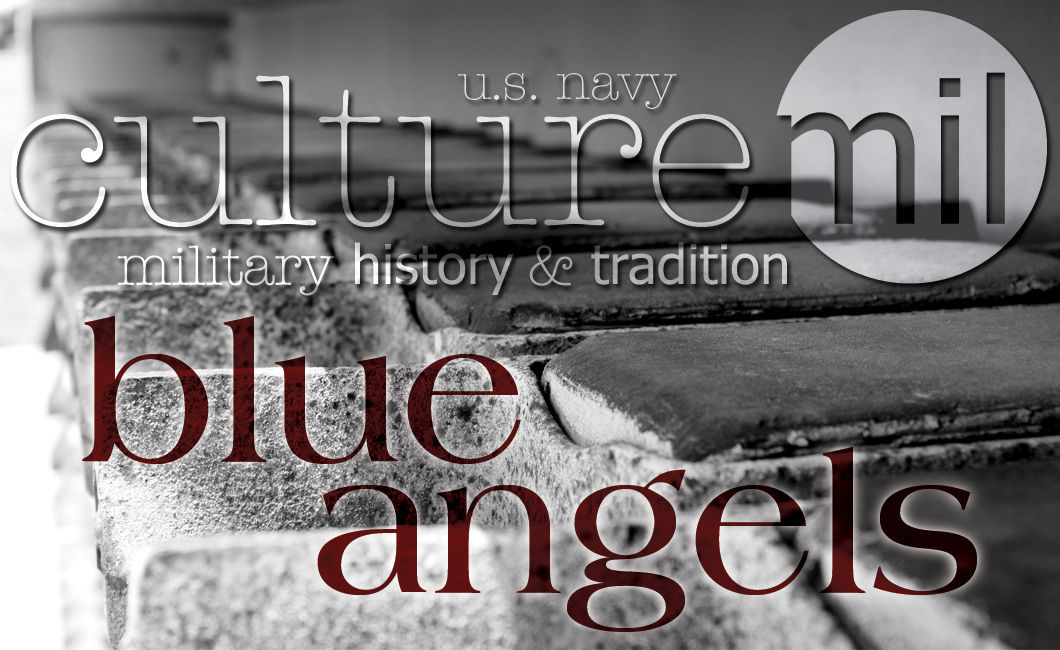- The flight team was first introduced as the “Blue Angels” in July of 1946 in Omaha Nebraska. The moniker came about after Right Wing Pilot Lieutenant Maurice “Wick” Wickendoll came across the name in the column Goings On About Town in the New Yorker Magazine, to which Voris declared, “That sounds great! The Blue Angels. Navy, Blue, and Flying!”
- Slot Pilot Lieutenant Junior Grade Ross “Robby” Robinson became the first Blue Angel fatality on September 29, 1946, when he failed to recover from a dive at NAS Jacksonville while performing a Cuban Eight maneuver. To date, 26 pilots among the Blue Angels ranks have died while performing.
- The Diamond Formation and the Diamond Loop and Diamond Barrel Roll maneuvers were introduced in 1947 by Flight Leader Lieutenant Commander Robert “Bob” Clarke.
- Flight Leader Lieutenant Commander Raleigh “Dusty” Rhodes designed the first official insignia in 1949, which is nearly identical to the insignia they use today.
- On August 20, 1949, the Blue Angels debuted the Grumman F9F-2 Panther, their first jet aircraft.
- The Blue Angels were disbanded by the Navy in 1950 in response to the Korean Conflict. They became the nucleus of “Satan’s Kitten,” Fighter Squadron 191 (VF-191), aboard the USS Princeton aircraft carrier.
- On October 25, 1951, Lieutenant Commander Roy Voris returned to reorganize the demonstration team, replacing Lieutenant Commander John “Johnny” Magda. Magda died in combat leading a strike against Chinese and North Korean troops on March 8, 1951.
- On May 15, 1954 (Armed Forces Day), the Blue Angels performed with the newly-formed Air Force Thunderbirds for the first time.
- In 1954, the team added Captain Chuck Hiett, their first Marine Corps pilot. A Marine position has been reserved ever since.
- After numerous relocations, the Blue Angels relocated to their present home base, NAS Pensacola, Florida, in June of 1955.
- In September of 1955 the team performed in Canada, their first time outside the United States.
- The Blue Angels transitioned to the Grumman F11F-1 Tiger at the end of 1955, which allowed them to add new maneuvers, as well as practicing high, tight and close flying.
- On July 4, 1963, the Blue Angels performed their 1,000th show in Lemoore, California.
- The team transitioned to the McDonnell Douglas F-4J Phantom II to at the end of 1969, the only aircraft flown by both the Thunderbirds and the Blue Angels.
- The team performed for the first time in South America in 1970, then conducted their first Far East tour in 1971.
- For the two-year period from March 1, 1970 to December 31, 1971, the Blue Angels were awarded the Meritorious Unit Commendation (Navy) in 1972.
- Tragedy struck on July 26, 1973, when two of the Blue Angels’ planes (F-4J Phantom II) collided, killing their Flight Leader, Left Wing Pilot and Crew Chief. The remainder of the season was cancelled and the Phantom-era ended.
- On October 8, 1977, the Blue Angels performed their 2,000th show in Atlanta, Georgia.
- At the completion of their 40th anniversary year, the Blue Angels revealed their present aircraft, the McDonnell Douglas (now Boeing) F/A-18 Hornet, only November 8, 1986.
- On September 7, 1990, the Blue Angels performed their 3,000th show in Grand Forks, North Dakota.
- Between August and September of 1992 the Blue Angels became the first U.S. military flight team to perform in Bulgaria, Russia and Romania.
- In 1996, the Blue Angels celebrated their 50th anniversary year.
- Landing a jet on the USS Harry S. Truman (CVN-75), the Blue Angels Flight Leader, Commander Patrick Driscoll, was the first to make this underway aircraft carrier maneuver.
- In 2014, for the purpose of oversight, an executive officer position is created, increasing the number of Blue Angels to 17.
- In 2016, the Blue Angels celebrated their 70th anniversary year, which also marked their Boeing F/A-18 Hornet’s 30th
- http://www.navy.mil/navydata/aircraft/b-angels/blues.html
- https://www.blueangels.navy.mil/history/
- https://www.faa.gov/about/initiatives/airshow/military/media/BlueAngels_Maneuvers_Manual.pdf
- http://blueangelsassociation.org/flight-teams/
- https://www.calendar-12.com/holidays/armed_forces_day/1954
- https://en.wikipedia.org/wiki/Blue_Angels
- http://www.nytimes.com/1973/07/27/archives/3-in-blue-angels-killed-in-collision-of-2-phantom-jets.html?mcubz=3
Written by Jenifer Chrisman on October 11, 2017.
“To most people, the sky is the limit. To those who love aviation, the sky is home.”
– Jerry Crawford
The Blue Angels were formed at the end of World War II by Chief of Naval Operations, Admiral Chester W. Nimitz, to maintain public interest in Naval Aviation. They performed their first flight demonstration at Naval Air Station (NAS) Jacksonville, Florida, their home base, on June 15, 1946. Led by Lieutenant Commander Roy “Butch” Voris, they flew a Grumman F6F-5 Hellcat. The Blue Angels were the second formal flying team in the world. Their predecessor, Patrouille de France, formed in 1931, still fly today.
Over the years, the Blue Angels have transitioned aircraft as more modern and technologically advanced crafts became available, allowing them to add more maneuvers.
| Blue Angels Flight Demonstration Aircraft | |||
|---|---|---|---|
| F6F Hellcat | 1946 | F11F-1 Tiger | 1957 - 1968 |
| F8F Bearcat | 1946 - 1949 | F-4J Phantom II | 1969 - 1974 |
| F9F-2 Panther | 1949 - 1950 | A-4F Skyhawk II | 1974 - 1986 |
| F9F-5 Panther | 1951 - 1955 | F/A-18 Hornet A/B | 1986 - 2010 |
| F9F-8 Cougar | 1955 - 1957 | F/A-18 Hornet C/D | IN TRANSITION |
| For further details, visit https://www.blueangels.navy.mil/history/. | |||
The Blue Angels perform a wide variety of air maneuvers, in High, Low and Flat Shows. For a composite list of their 2016 maneuvers, along with diagrams detailing each, visit: https://www.faa.gov/about/initiatives/airshow/military/media/BlueAngels_Maneuvers_Manual.pdf. Photos of each year’s teams can be viewed at http://blueangelsassociation.org/flight-teams/.
In the more than 70 years since their inception, hundreds of millions of fans have watched the Blue Angels perform. And they will continue to delight audiences for years to come.
Significant Events:
Sources:



